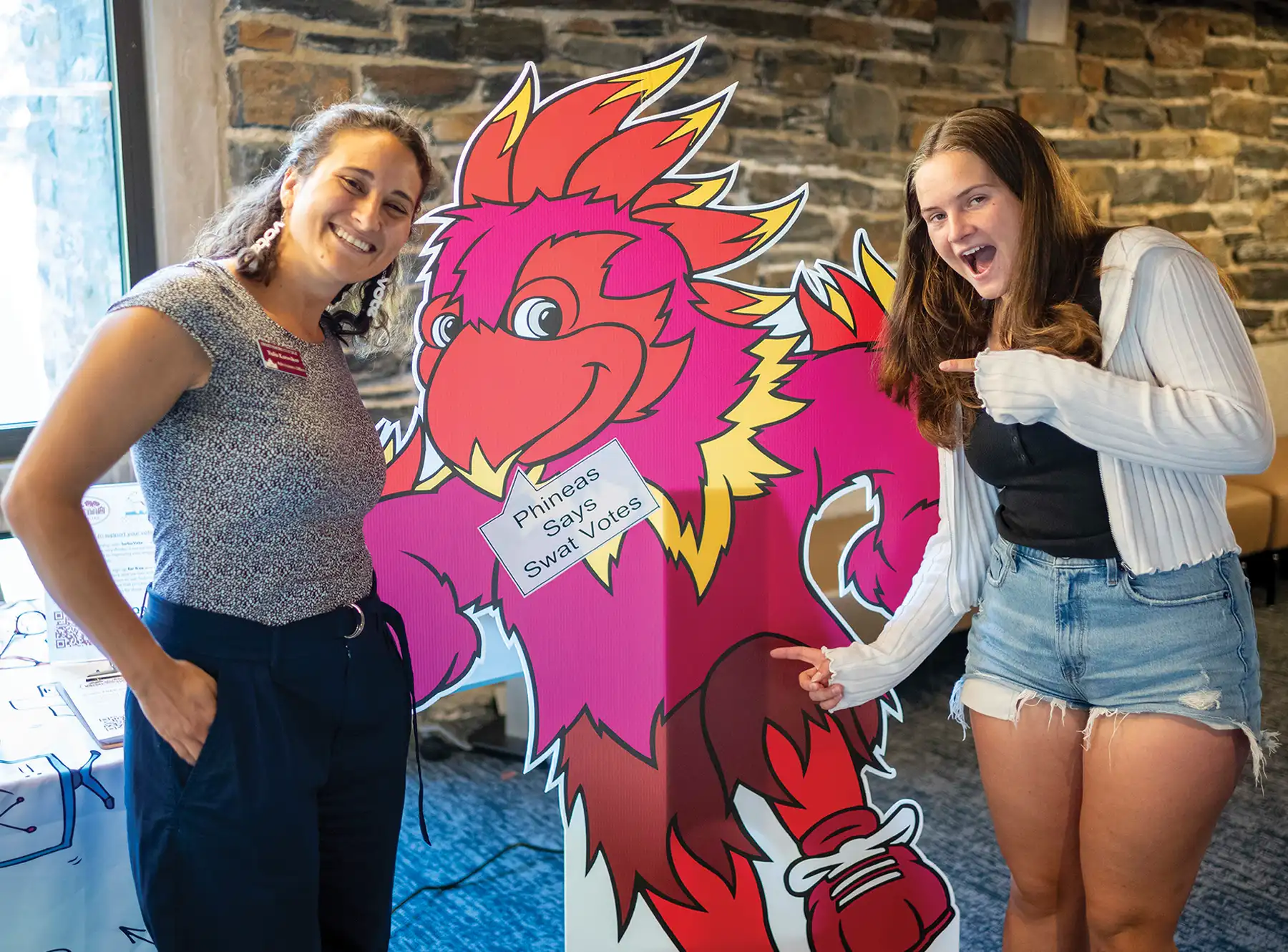
This classic machine still symbolizes creativity and the power of communication.
pg. 83
Gerd Rosenblatt ’55
Devi Ramkissoon ’06
This Underwood typewriter belonged to poet W.H. Auden H’64 and is part of the collection in the McCabe Library’s Rare Book Room.
Photo by Laurence Kesterson.
The World From Here
campbell

With the days to the November election slipping away, the national temperature continued to rise. In the midst of such discord, in this Bulletin issue, we wanted to talk … about talking.
In “I Think We Should Talk” (pg. 22), we turn to political science faculty and alumni who offer insight on this moment in American political history. They explain what is unique — and what is not — about a fractured citizenship and a fragile democracy. And importantly, they share their thoughts on what may help the country navigate more turbulence.
In something of a response, “Words to Live By” (pg. 34) opens the door for some of Swarthmore’s poets to weigh in on the power of the written word to help make sense of the world in times of crisis and confusion.
Looking Back (pg. 83) highlights the College’s long history with prose and verse as we showcase W. H. Auden H’64’s stately, and slightly forbidding, Underwood typewriter, part of the collection in McCabe Library’s Rare Book Room. Poetry is experiencing a peak in popularity on campus and among alumni.
We know we could not include every Swarthmore poet, but the voices shared represent a gleaming portion of the talent in this diverse and creative community.
Continuing the theme of communication, “Strength in Storytelling” (pg. 44) is a profile of Elizabeth Hansen Shapiro ’02 that examines the promise of investing in the power of local press.
Ending this fall edition on a note of hope, “Empowering Young Minds” (pg. 46) celebrates the vibrant Summer Learning Program of the Chester Children’s Chorus. CCC students explore the campus from the ground up and, with each new season, add their own stories and voices to Swarthmore’s ongoing conversation with the world.
swarthmore college bulletin
Andy Hirsch
Director of Content Strategy
Mark Anskis
Editor
Kate Campbell
Managing Editor
Ryan Dougherty
Editorial Specialist
Nia King
Class Notes Editor
Heidi Hormel
Designer
Phillip Stern ’84
Photographer
Laurence Kesterson
Administrative Coordinator
Lauren McAloon
Editor Emerita
Maralyn Orbison Gillespie ’49
Email: bulletin@swarthmore.edu
Telephone: 610-328-8533
We welcome letters on articles covered in the magazine. We reserve the right to edit letters for length, clarity, and style. Views expressed in this magazine do not necessarily reflect the opinions of the editors or the official views or policies of the College. Read the full letters policy at swarthmore.edu/bulletin.
Send letters and story ideas to
bulletin@swarthmore.edu
Send address changes to
records@swarthmore.edu
Printed with agri-based inks.
Please recycle after reading.
©2024 Swarthmore College.
Printed in USA.

On Our Radar

america’s mushroom capital
— BILL PARKER ’76 East Hampton, Conn.
Obviously, I found the article most interesting. I always enjoy the Bulletin.
— SUSAN GUTTERMAN ’59 New York, N.Y.
more crosswords, please

—TIELA CHALMERS ’80 Sacramento, Calif.
A CRITICAL CONNECTION?
The article is of special interest when considering the history of Howard Florey, an Australian whose studies and work in England began as a Rhodes Scholar in 1922. That year Florey met an American Rhodes Scholar, John Fulton, with whom, importantly, he would reconnect in the USA during WWII. …
The question arises: Was there communication and knowledge exchange between Florey or his research team and G. Raymond Rettew? Was it just coincidental that, in 1942, Rettew and the Sharples Cream Separator Company in West Chester developed a method to produce large quantities of penicillin at the same time Florey and Chain (Nobel laureates along with Alexander Fleming in 1945) and scientists at the Northern Regional Research Laboratory of the U.S. Department of Agriculture in Peoria, Ill., succeeded in doing so?
Perhaps, I think it’s probable, knowledge was shared; perhaps some critical connection between an Australian, an Englishman, and a Swarthmore-trained chemist at Wyeth Labs in West Chester enabled production of large quantities of penicillin (beginning in 1943) for life-saving treatment of thousands of infections during WWII.
—MARK DEWITTE ’72 Lyndell, Pa.

love the cover
—JUDITH NORDBLOM ALGER ’60 Chicago, Ill.
SIBLING CHEERS
— LINCOLN POTTER ’55 Lexington, Mass.
Family Planning Matters

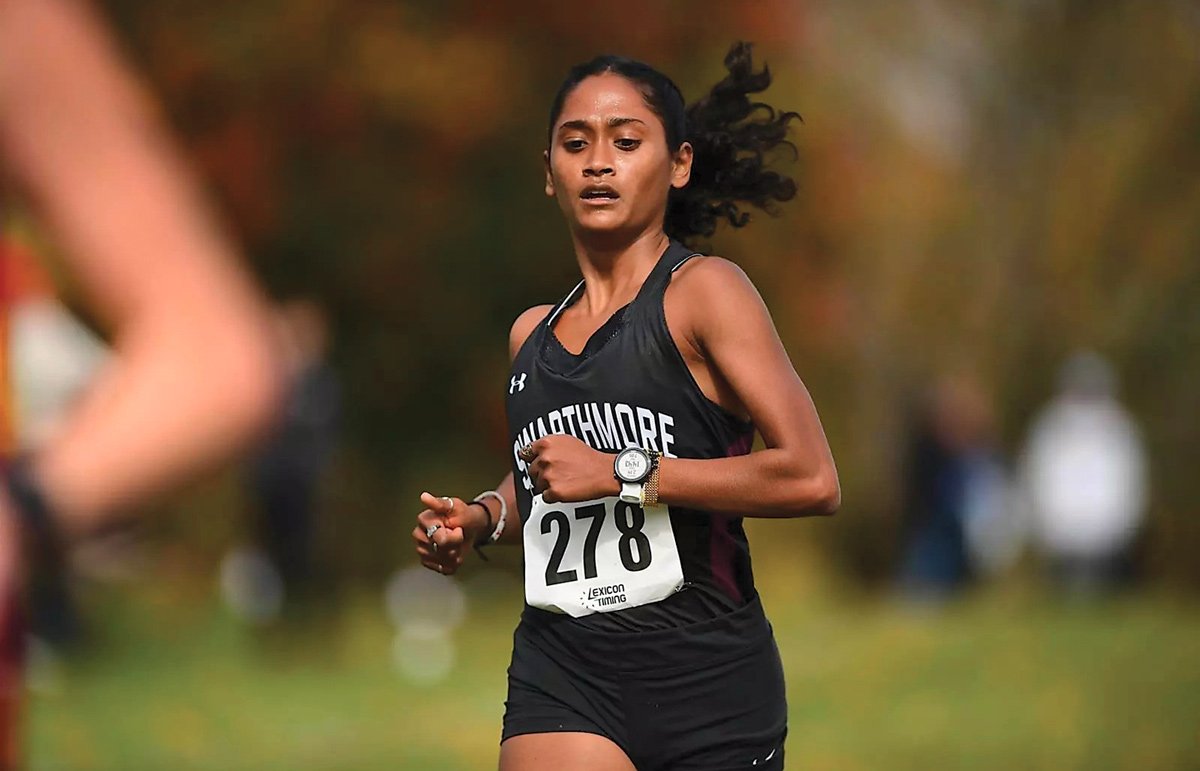
studentwise: Finding Her Path
In high school, she ran track to help stay in shape for soccer. But then the pandemic hit, and her world shifted. Running became a source of both solace and connection.
“It was one of the only ways to be around friends and loved ones,” says Hasan, who basked in the camaraderie and team spirit of these meetups.
Striving to carry that momentum to Swarthmore, Hasan walked on to the cross country team. But with that came obstacles. She faced imposter syndrome, wondering whether she belonged with the team, and if she could juggle the rigors of athletics and academics.
Submit your publication for consideration: books@swarthmore.edu
HOT TYPE: New releases by Swarthmoreans
Anne Rosenbaum Vohl ’55
My Twelve Wars
Self-published

Christopher GoGwilt ’83
The K-Effect: Romanization, Modernism, and the Timing and Spacing of Print Culture
Fordham University Press
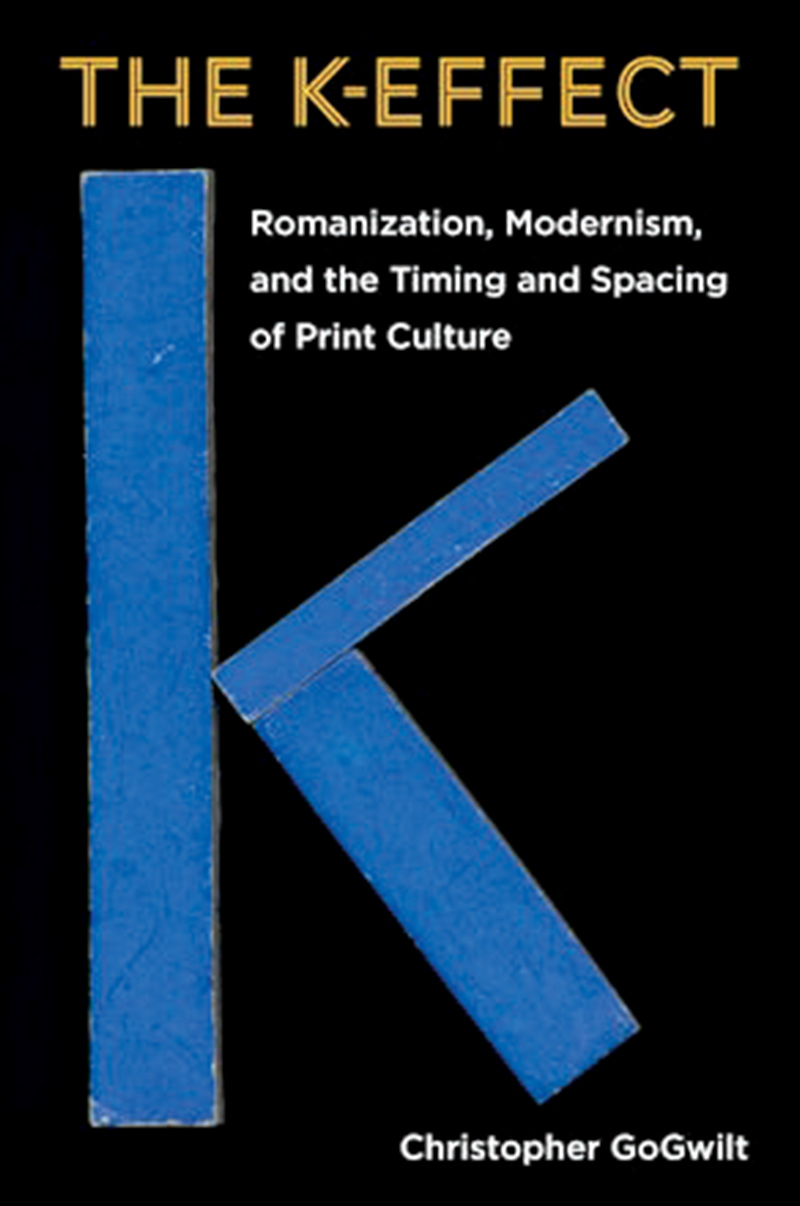
A Bigger “Us”
That early experience of displacement galvanized Koopman to pursue a career understanding what divides us, what brings us together, and how to coexist and resolve differences peacefully.
Koopman is an associate professor at the School of Peace and Conflict Studies at Kent State University, where, in 1970, four students were killed and nine others wounded by National Guard troops during a campus antiwar demonstration.
The killings sent a shock wave through the nation, and Koopman’s position was one of three created by Kent State in remembrance on the 50th anniversary of the shootings.
sharing success and stories of swarthmore
common good

Make Yourself at Home
The students were selected from one of the most diverse applicant pools in the College’s history.
“I am excited to welcome the Class of 2028 to campus with great joy, as the 2024 admissions cycle was one of the most transformative in recent years,” said Jim Bock ’90, vice president and dean of Admissions.
“I’m so grateful for the dedication, collaboration, and ingenuity of my colleagues to bring us to this point.”
—RYAN DOUGHERTY
A Hidden Gem
here are relatively few opportunities to play shogi, a traditional board game of strategy similar to chess, in the United States. And there may be just one place to play shogi during your undergraduate years — Swarthmore College.
“Shogi is related to Western chess,” says Alan Baker, professor and chair of the Philosophy Department. “The best way of thinking about it is like a cousin of Western chess.”
Baker was introduced to the game while visiting Japan in his mid-20s.

artistic exploration


“It was mesmerizing and thrilling to me, transforming this ball of clay into whatever I wanted to see,” says Anderson, now a renowned ceramicist based in Los Angeles, fresh from his second solo exhibition at Sargent’s Daughters gallery, which ran from February to April of this year.
Since Swarthmore, Anderson has been assembling a ravishing body of ceramic work.
His complex, multilayered forms coated with vivid and shimmering glazes explore weighty topics like queerness and race.
But his clay creations also teeter on the edge of humor and whimsy. His works, from vessels to sculptural forms and paintings, incorporate cartoonish elements. A white rabbit has love hearts for ears. A lemon wearing red lipstick gazes into a pond like Narcissus.

Perpetual Motion
In 2005, at age 71, he attempted to ride from his home in Berkeley, Calif., to Swarthmore for his 50th reunion. He met his now longtime riding partner, Lori Cherry, on the trip, which took a dangerous turn when they were hit by a car in Dodge City, Kan.
“[The driver] hit Lori’s rear wheel. I got hit really solid and flew over the hood of the car,” says Rosenblatt. “I did a somersault or two and landed hard on my feet.”
Shockingly, his injuries were misdiagnosed as mere sprains in Kansas, so he kept biking.
Just & Green

“I didn’t think about these practices as sustainability,” she says. “For me, they were practices of survival.”
Today, Ramkissoon concentrates her efforts on helping Philadelphia-area businesses adopt sustainable practices, ranging from composting to clean energy. It’s a worthy investment, she says. In the long run, there is a higher price for inaction.
I Think We Should Talk


The historic church, about eight miles from Swarthmore’s campus, is where Reeves attends services each Sunday. King’s storied victories for civil rights permeate his thoughts about the future.
But politics in the U.S. today — and the lack of progress on criminal justice issues — have him worried.
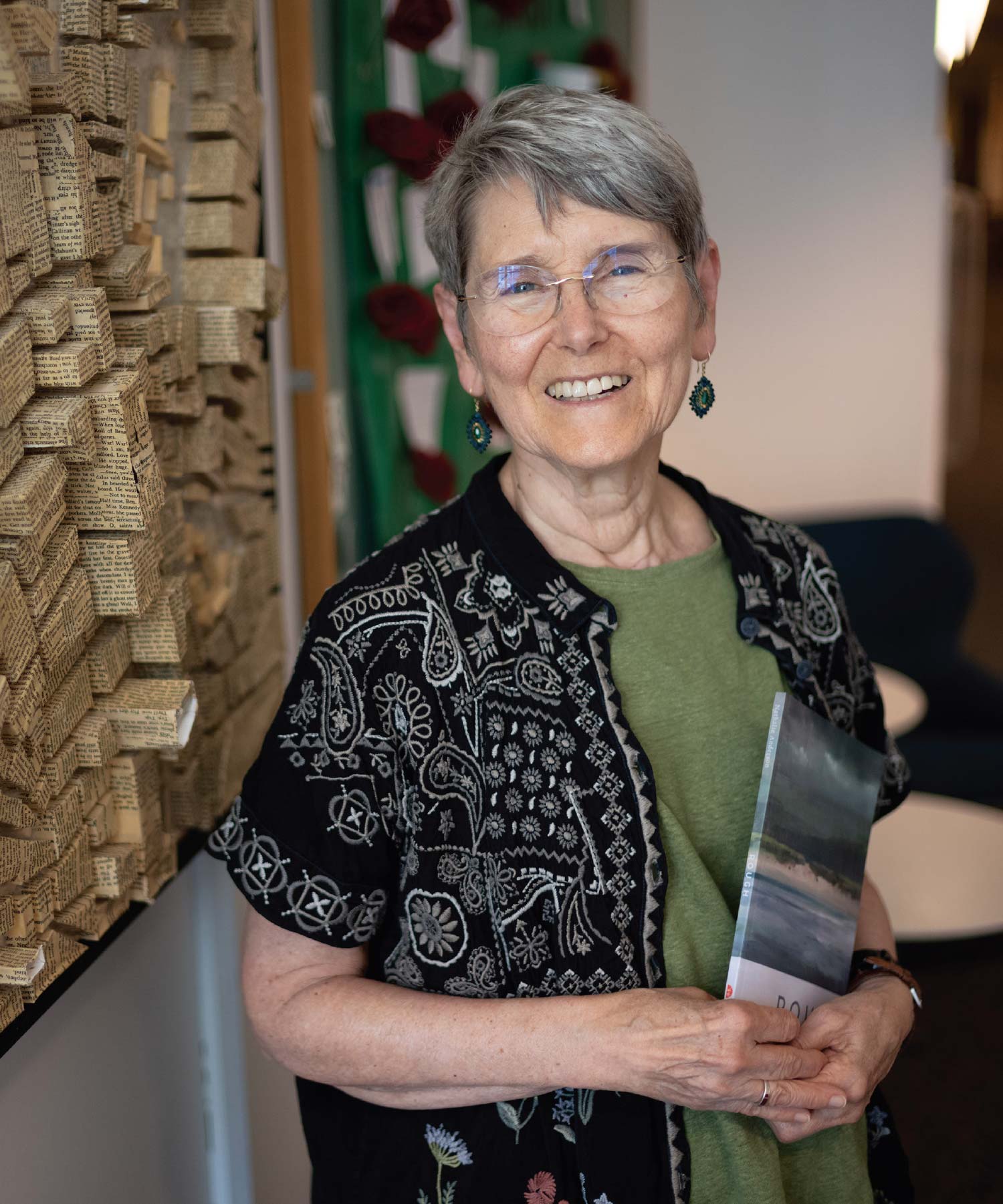
Words to Live By

It was an epiphany prompted by her participation in the advanced poetry workshop led by Nathalie Anderson, a poet and librettist who retired from her role as an English professor in 2021.
Anderson, who is the Alexander Griswold Cummins Professor Emerita of English, directed the College’s program in creative writing for almost four decades, during which she nurtured an orchard of student poets who have gone on to win awards for their work. These alumni treasure their memories of workshops in which Anderson was a galvanizing and deeply enriching presence.

Gregory Rec, Chief Photographer, Maine Trust for Local News.
Strength in Storytelling — One Community at a Time
Reimagining local press as an investment in democracy
In 1941, the then 17-year-old Elizabeth Morningstar of Saginaw, Mich., dropped out of school, married General Motors worker Herbert Hansen, and, within a year, gave birth to Herb Jr., the first of nine children.
A wry humorist, Betty Hansen began writing about her chaotic home — which she nicknamed Scotland Yard after the London police force’s “We Never Sleep” motto — for the Saginaw Daily News.
Her column earned instant popularity, chronicling the “muddy togetherness” of a Midwestern house where dresser drawers were always open, a toddler was always jumping on a bed, and someone was always dancing impatiently outside the bathroom door.
Empowering Young Minds
The Chester Children’s Chorus, celebrating its 30th anniversary, offers a mix of academics and music at its Summer Learning Program
n a warm july morning, 17-year-old Armani Madden sits in a College classroom, working on a math problem with 8-year-old Aiya Brooks. The Chester Children’s Chorus (CCC) is a nonprofit that provides year-round music and academic education to children who perform 10-12 community-wide concerts annually in the Delaware Valley.
On this summer day, the classroom is buzzing with the chatter of 30 rising third graders, each engaged in solving the math equations that Dana Semos, the CCC and Summer Learning Program (SLP)’s managing and education director, has written on a whiteboard.
When Aiya writes the correct answer, Madden smiles and says encouragingly, “There you go!”
Semos, watching from the front of the class, joins them in a smile, beaming with pride.
“In math, I sometimes struggle,” Aiya says. “But when I work on it with my counselors, they break it down so I can understand better.”
Rachel Warren
In addition to music, reading, and math, the Summer Learning Program includes science, art, swimming, cooking, photography, field trips, and more. At right, McKenzie Salmon explores a hollow tree trunk.
class notes

Alumni Weekend 2025
May 30–June 1
A remarkable part of Alumni Weekend is that feeling of picking up right where you left off. We hope you’ll come back to campus this spring to celebrate your milestones, rekindle friendships, connect across generations, and rediscover that You Are Here at Swarthmore.
SwatTalks
SwatTalks is an Alumni Council initiative to engage the broader Swarthmore community in seminars featuring alumni and faculty members excelling in their fields. Register for the next SwatTalk about the 2024 election, slated for mid-November, and find recordings of previous programs.
bit.ly/SwatTalks
Alumni Events
From opportunities to hear from President Valerie Smith to informal happy hours and book clubs, there are many opportunities to connect with classmates and fellow alumni near you. Find up-to-date event information for alumni and families.
swarthmore.edu/AlumniEvents

Your support makes a Swarthmore education extraordinary and accessible.
Your support makes a Swarthmore education extraordinary and accessible.

their light lives on
-
Arthur “Art” J. Prange NV
Art, a research psychiatrist,
died April 6, 2024.He attended the College, then transferred to the University of Michigan where he earned his medical degree. He was in the first residency class of the Psychiatry Department at N.C. Memorial Hospital of the University of North Carolina (UNC) School of Medicine, remaining at UNC for more than four decades. Art’s research focused on the endocrine system’s function and its relationship with depression, supported largely by National Institutes of Health grants. He published more than 250 peer-reviewed studies as well as receiving numerous awards and recognitions.
-
Charles “Charlie” B. Van Benschoten NV
Charlie, an engineer and athlete, died May 19, 2024.
He attended the College and earned his bachelor’s in civil engineering at Rutgers University and was a municipal engineer/director of public works for three New Jersey municipalities, finishing his career as Monmouth County engineer for 16 years. A golfer, Charlie helped design and found Warrenbrook Country Club. He was a member and past president of various engineering societies and associations, including Tau Beta Pi National Honorary Engineering Society and the New Jersey Society of Municipal Engineers.
-
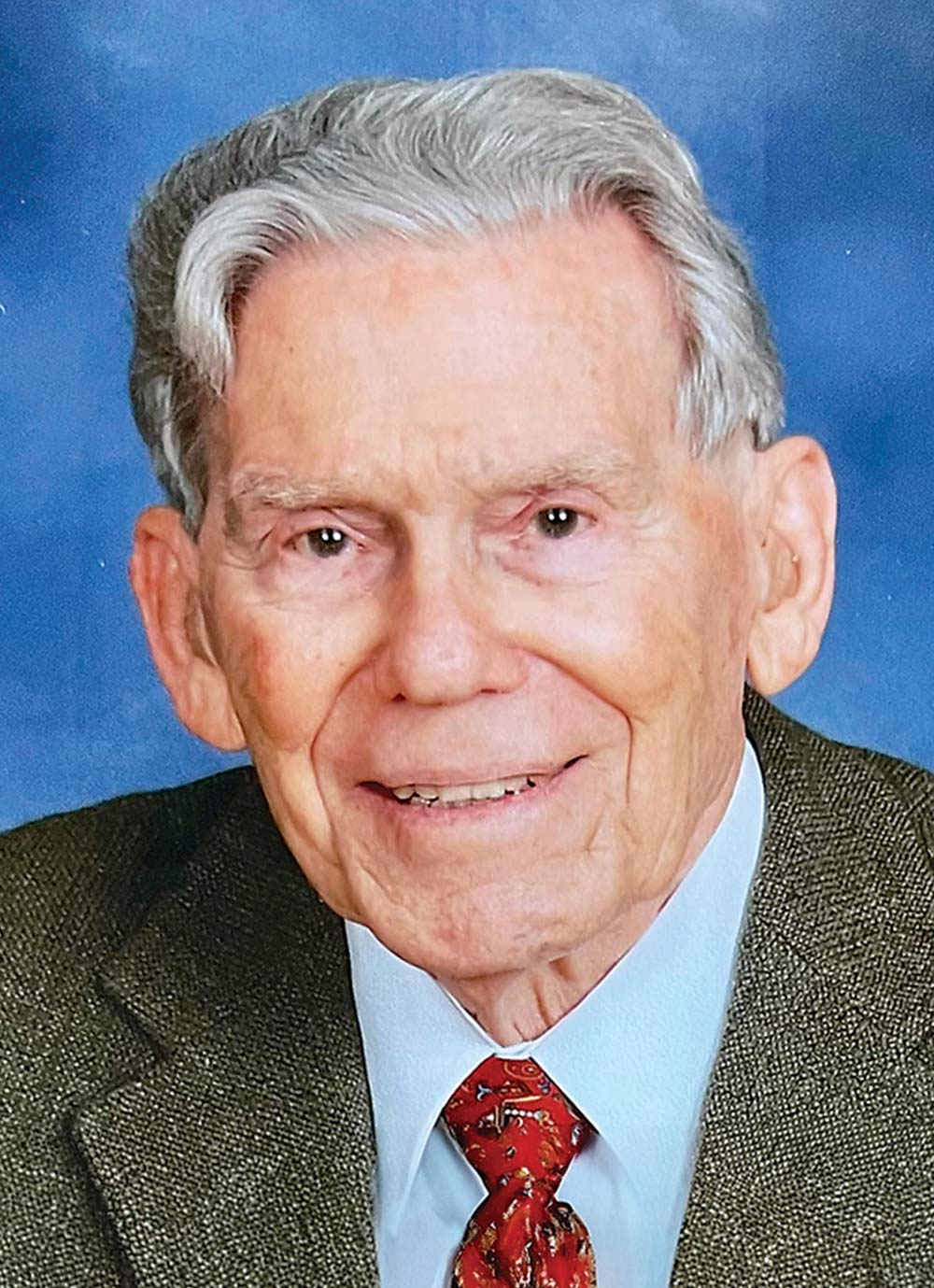 Edward “Ted” M.T. Jones ’44
Edward “Ted” M.T. Jones ’44Ted, an electrical engineer and entrepreneur, died March 5, 2024.
He earned a bachelor’s in engineering at the College, where he played varsity lacrosse; earned a Ph.D. in electrical engineering at Stanford University following two years of service in the Navy; and researched passive microwave devices. Ted co-founded TRG-West in 1962, which designed and built large broadcast and collection antennas and was acquired by Control Data in 1967. He also co-founded TCI International in 1968 to design and build antennas and collection systems, from which he retired as chairman of the board.
-
 Mary “Mimi” Steytler Park ’47
Mary “Mimi” Steytler Park ’47Mimi, an English literature major and homemaker, died June 16, 2024.
She earned a bachelor’s in English literature at the College. After the death of her first husband, she married Dick Park in 1957 and was a homemaker and mother of three. The couple retired to Belgrade Lakes, Maine, in 1990, and four years after being widowed, Mimi moved to Piper Shores in 2005. She was a charter member of Union Church of Belgrade Lakes.
-
Esther Moore Power ’46
Esther, a volunteer and lover of local history, died April 3, 2024.
The class secretary, she earned a bachelor’s in psychology at the College and studied French at Université Laval in Canada. With an interest in local history, Esther volunteered in the archaeology department of the Cincinnati Museum Center for 20 years; at the Cincinnati Historical Society, as records keeper and archivist for the Village of Terrace Park; with the League of Women Voters; and with the University of Cincinnati faculty wives’ groups.
-
C. Russell de Burlo Jr. ’47
Russell, a financial planner and wide-ranging volunteer, died Feb. 24, 2024.
He attended the College, joined the Navy, returned to Swarthmore, and earned a bachelor’s in engineering. Then he earned an MBA from the Wharton School and a Ph.D. in business administration from Harvard Business School. Russell worked at Tufts University from 1949–89, and was the founder of The de Burlo Group, a financial planning company, with which he remained involved until his death. Additionally, he was a member of the boards and committees of numerous organizations such as the CFA Institute, Friends Meetings, and land trusts.
-
Sue McEldowney Dean ’48
Sue, a potter who studied zoology, died May 8, 2024.
She earned a bachelor’s in biology at the College, where she was in the Hamburg Show and a part of WSRN, and earned a master’s in zoology from the University of Michigan. While in Tennessee with her husband, who was on sabbatical leave in 1968–69, Sue took a pottery class that led to her career as a potter. After their return to Fairbanks, Alaska, her family built her a studio, where she made pottery for friends, family, local galleries, and commissions into her early 90s.
-
 Joyce Baldwin Kidder-Davis ’49
Joyce Baldwin Kidder-Davis ’49Joyce, an historian and advocate for democratic principles, died April 22, 2024.
She earned a bachelor’s in history with Highest Honors and Phi Beta Kappa at the College, was the recipient of a Fulbright Scholarship for graduate studies at the University Libre de Bruxelles in Belgium, and earned her master’s in history at Columbia University. Joyce was a lecturer in history at the City College of New York, and was engaged in local political activities and voter registration, including with the League of Women Voters.
looking back

That poem elicited the exasperated response “O God, what rubbish” from its author. One of the classes Auden taught was entitled Romanticism from Rousseau to Hitler, and the Libraries are fortunate to have his original typed notes, perhaps written using the typewriter (pictured here) that he left behind.
He amusingly wrote to Ursula Niebuhr, “My seminar on Romanticism starts tomorrow.

Voting Matters
What do you see as the mission of GOTV?
One reason that creating this committee was a priority for President Valerie Smith in 2018 was that voter turnout among Swarthmore students was below that of some peer institutions. That was really surprising, because we tend to think of our students as activists. Part of what this committee can do is help students connect their activism to voting.
We’re focused on trying to reach young voters and get them to turn out. The last census showed us that Millennials and Generation Z make up about 44% of potential voters. They really do have power if they turn out. GOTV stresses that voting allows for the possibility of positive change, and that young people can lead the way.
What do you say to students who feel ambivalent about voting?
I understand where that comes from. Some people distrust the electoral system. They’re disillusioned with politics. They’re aware of the barriers that really target young people and communities of color, and they care deeply about social justice around the world. We’re in a presidential election cycle that can feel surreal or overwhelming. But I’m passionate about the opportunity, through voting, to move the agenda forward for the things people care about. There may not be an ideal candidate, but I ask them to consider who can help them see progress. Or maybe there’s an issue they want to focus on. We try to focus less on candidates and more on students’ ability to participate.

phineas and friends
Yulia Korovikov, associate dean in Admissions, and Danika Grieser ’26 generate some excitement for voter registration at the start of the fall semester at the Office of Student Engagement.
